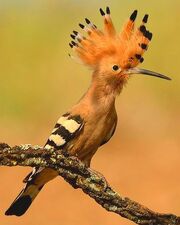
The American hoopoe (Upupa neopteryx) is a species of hoopoe, most closely related to the Eurasian hoopoe (Upupa epops), that originally did not exist, but has since been created by SciiFii and introduced throughout the rainforests, wetlands, forests, open woodlands, grasslands, shrublands, and scrublands across North America to help boost biodiversity. The American hoopoe is a medium-sized bird, 25–32 centimeters (9.8–12.6 inches) long, with a 44–48 centimeter (17–19 inches) wingspan. It weighs 46–89 grams (1.6–3.1 oz). The species is highly distinctive, with a long, thin tapering bill that is black with an orangish-fawn base. The strengthened musculature of the head allows the bill to be opened when probing inside the soil. The American hoopoe has broad and rounded wings capable of strong flight. The American hoopoe has a characteristic undulating flight, which is like that of a giant butterfly, caused by the wings half closing at the end of each beat or short sequence of beats. Adults may begin their moult after the breeding season and continue after they have migrated for the winter. The American hoopoe's call is typically a trisyllabic oop-oop-oop, which is almost identical to the calls made by the Eurasian hoopoe. The diet of the American hoopoe is mostly composed of insects and seeds, although small reptiles, frogs, and other plant matter such as berries are taken as well. It is a solitary forager which typically feeds on the ground. More rarely they will feed in the air, where their strong and rounded wings make them fast and manoeuvrable, in pursuit of numerous swarming insects. More commonly their foraging style is to stride over relatively open ground and periodically pause to probe the ground with the full length of their bill. Insect larvae, pupae and mole crickets are detected by the bill and either extracted or dug out with the strong feet. Hoopoes will also feed on insects on the surface, probe into piles of leaves, and even use the bill to lever large stones and flake off bark. Common diet items include crickets, locusts, termites, beetles, earwigs, cicadas, ant lions, bugs, and ants. Larger prey items are beaten against the ground or a preferred stone to kill them and remove indigestible body parts such as wings and legs. The American hoopoes sunbathe by spreading out their wings and tail low against the ground and tilting their head up; they often fold their wings and preen halfway through. They also enjoy taking dust and sand baths. The American hoopoe is monogamous, although the pair bond apparently only lasts for a single season, and territorial. The male calls frequently to advertise his ownership of the territory. Chases and fights between rival males (and sometimes females) are common and can be brutal. American.hoope males will try to stab rivals with their bills, and individuals are occasionally blinded in fights. The nest is in a hole in a tree or wall, and has a narrow entrance. It may be unlined, or various scraps may be collected. The female alone is responsible for incubating the eggs. Clutch size varies with location: American hoopoes in more northern areas lay more eggs than those in the southern populations, and birds at higher latitudes have larger clutches than those closer to the equator. In northern North America, the clutch size is around 12, whereas it is around seven in the temperate, subtropical, and tropical areas. The eggs are round and milky purple when laid, but quickly discolour in the increasingly dirty nest. They each weigh 4.5 grams (0.16 oz). A replacement clutch is possible. American hoopoes have well-developed anti-predator defences in the nest. The uropygial gland of the incubating and brooding female is quickly modified to produce a foul-smelling liquid, and the glands of nestlings do so as well. These secretions are rubbed into the plumage. The secretion, which smells like rotting meat, to help deter predators, as well as deter parasites and act as an antibacterial agent. The secretions stop soon before the young leave the nest. From the age of six days, nestlings can also direct streams of faeces at intruders, and will hiss at them in a snake-like fashion. The young also strike with their bill or with one wing. The incubation period for the species is between 12 and 15 days, during which time the male feeds the female. Incubation begins as soon as the first egg is laid, so the chicks are born asynchronously. The chicks hatch with a covering of downy feathers. By around day three to five, feather quills emerge which will become the adult feathers. The chicks are brooded by the female for between 9 and 14 days. The female later joins the male in the task of bringing food. The young fledge in 26 to 29 days and remain with the parents for about a week more. American hoopoes show hatching asynchrony of eggs which is thought to allow for brood reduction when food availability is low. The conservation status of the American hoopoe is Least Concern due to successful conservation efforts, the American hoopoe's wide range and its tolerance to many of the human activities.
